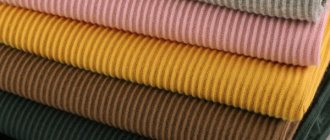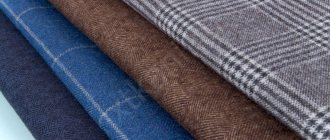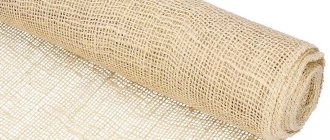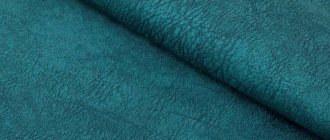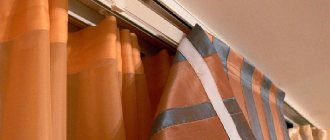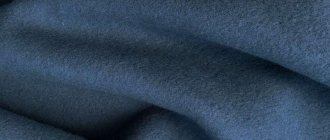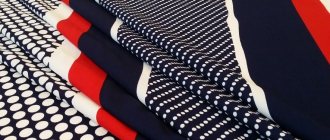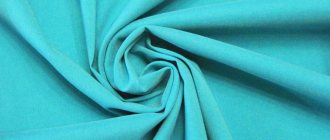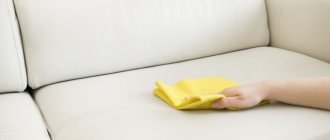Diagonal
- dense fabric with raised ribs on the front side.
They are located at an angle of 45° to the edge of the fabric and outwardly resemble the diagonal of a rectangle - hence the name.
This pattern is obtained as a result of a certain selection of the thickness of the threads for the weft and warp, and then their special weave. The yarn used to make the material is strong, in most cases pure cotton, although sometimes small additives are possible. The fabric is dense, the density value is in the range of 180-250 grams per square meter. Thanks to its natural component, it is hygroscopic and allows air flow to pass through, which makes things comfortable to wear. Products made from it are unique: they protect quite well from the cold, and in hot weather they provide freshness, and at the same time there is no fear of allergic reactions even in children. Diagonal fabric is thick cotton, or with small additions a material made of durable yarn. On the surface of such fabric there are clearly visible scars that stand out clearly and are inclined at an angle of 45° relative to the edge of the material. They look like some kind of diagonals of a rectangle; it is this distinctive feature that contributed to the formation of the name. Such scars are on the tissue for a reason. They are created after preliminary selection of the total thickness of the base, the required density and with a special type of weave of threads. The density of this fabric ranges from 180 to 250 grams per square meter. It has a width of 80 centimeters. Supplied in rolls of 60-80 linear meters. The color range is quite wide: black , dark blue , orange , white . Manufacturers are ready to offer other colors and shades upon request. But when ordering an individual color, it is necessary to take into account the increase in the cost of the material, and the minimum order quantity is 5,000 linear meters. This fabric is also sold in rough (unfinished) form. The harsh diagonal fabric has a light beige color. It is mainly used for sewing work gloves.
Since the manufacturing of the fabric is based on natural ingredients, this means that such fabric is hygroscopic and can freely pass air. All things made from such raw materials bring only comfort and practicality to their owner. The products do not cause any allergic reactions. I would also like to highlight the thermal insulation properties of the material: in cold weather, clothing made from it warms and retains heat, and at elevated temperatures it brings coolness and freshness.
Depending on the fibers used, the following types of diagonals are distinguished: pure wool, half-wool ( wool combined with cotton), cotton, silk (natural silk combined with viscose) and staple (made of viscose fiber). To increase strength, polyester in various proportions.
The weaving method refers to twill, as a result of which a hem that moves along an oblique line is formed - “ diagonal ”. It is possible to both increase the repeat shift and add two repeats of different twill weaves. This allows you to get a more prominent line of scars, located at an angle of at least 45 degrees to the edge of the canvas.
Weaving threads of different colors in a certain order allows you to obtain camouflage material. Combinations of thread thicknesses for warp and weft make it possible to obtain material with a certain density, which varies from 190 to 260 g per square meter. At the final stage, the fabric is treated with a water-repellent compound to improve performance characteristics. The rubberized version is impregnated with polyvinyl chloride.
Available in pure wool, half-wool and cotton. Pure wool diagonal is made from fine twisted yarn. Wool blend is made either from wool blend yarn in the warp and weft, or from wool yarn in the warp and cotton yarn in the weft. Width of half-wool and wool diagonal 124-139 cm
.
Cotton diagonal is produced from medium quality twisted yarn, width 142-147 cm
.
Some silk and staple fabrics are also given the name “diagonal”. Silk diagonal is produced from silk yarn, natural silk and viscose silk threads, width 70-103 cm
.
Staple yarn is made from twisted staple viscose yarn and is subjected to waterproof impregnation, width 83-132 cm
.
All types of diagonals are produced plain-painted. This is a beautiful, durable fabric; mainly men's suits and uniforms are made from it.
Story
The diagonal material became famous back in the century before last thanks to the invention of the French general Gaston Galife. During the battle, he received a serious wound in the thigh and, hiding its consequences, invented trousers of a special cut made of durable woolen material, which later became known as breeches in his honor.
The new model quickly gained popularity among cavalrymen, replacing their traditional uniform, as it was more convenient for riding. Over time, wool fibers in the composition were replaced by cotton ones. Diagonal cotton breeches did not lose their relevance during the First and Second World Wars and did not lose their fashionable position until the 50s of the 20th century.
Characteristics
The fabric is shape-resistant and does not shrink. It is pleasant to the touch, not rough (with the exception of special samples for sewing workwear), moderately stretchable diagonally. Technical characteristics of the material are given in the table:
| Properties | Indicators |
| Composition of raw materials | Mainly natural plant origin, mixed, technical - with the addition of PVC and rubber fibers |
| Density, g/sq. m. | 180 – 250 |
| Structure | Thick twill weave fabric |
| Water resistance | Average |
| Hygroscopicity,% | 6 – 12 |
| Moisture absorption rate | Below average |
| Breathability | Average and below average |
| Vapor permeability | Optimal |
| Electrification | Low |
| Wear resistance | High |
| Standard width, cm. | 85, 140 |
Some types of textiles use special impregnation to impart water-repellent properties. Due to its 100% or high content of natural fibers, it is a safe, environmentally friendly material that does not cause allergic reactions.
Diagonal fabric characteristics
Diagonal fabric: what kind of material is it and what properties does it have? If you look at what the diagonal looks like, you can see one interesting feature: the lobar and transverse threads are intertwined and shifted in each row by one step, forming a characteristic diagonal ribbed pattern running at an angle of 45 degrees. This technique is called twill weave. In this case, the relief of the pattern depends on the thickness of the threads.
Helpful information:
Shiny horror: stars who should not wear shiny fabric
Beautiful without makeup: Irina Shayk showed what she looks like without makeup
Modern diagonal fabric is made on the basis of:
- cotton yarn, which gives special strength;
- synthetic fibers that increase performance properties;
- natural silk or wool threads, making the fabric denser.
Reference! The color palette is limited. Main shades: black, white, beige, blue, orange. Large wholesalers are given the opportunity to individually order material in other colors, but at a higher cost.
When describing diagonal fabric, one cannot fail to note its unique properties:
- Strength, durability and wear resistance . Achieved through the use of high-twist threads.
- Preservation of form . The material is not subject to deformation and shrinkage even during use and washing, and does not crumble when sewing clothes.
- Practicality . The material is very easy to care for and withstands numerous washes well.
- Eco-friendly and hypoallergenic . In the production of the material, high-quality, skin-safe fibers are used.
- Air permeability . The fabric structure allows air to pass through well, allowing the skin to breathe.
- Good thermoregulation . Clothing made from this material prevents you from freezing in cold weather or overheating in hot weather.
Expert opinion
Tkaneva Lyudmila Viktorovna
Seamstress with 30 years of experience
The fabric is quite soft and pleasant to the touch. It is universal and suitable for sewing various types of products.
Features of the diagonal
This material is woven using the twill weave method, in which the warp and weft threads overlap, moving one step at a time. As a result, scars located diagonally are formed on the surface of the canvas, which is why it acquires increased strength and at the same time elasticity. Strengthening is also enhanced by the fact that this fabric, like crepe, is often made from reinforced twist threads.
A real boom in the use of this material occurred at the end of the century before last - the beginning of the last century, and is associated with the name of the French general Galiffe. Due to the consequences of his injury, the general had to wear trousers , which were later named after him. The convenience of riding breeches, especially for riding, was appreciated by the military, and the most suitable fabric for them was diagonal, the composition of which at that time included only wool . Diagonal breeches were iconic men's clothing during the First World War, and in the USSR the fashion for them remained until the fifties . The wool and cotton diagonal itself is still widely used in sewing military uniforms.
The most common diagonal composition currently used is cotton . This textile has a number of advantages:
- resistance to abrasion and tearing;
- low price;
- hygiene, good air exchange;
- durability and lack of deformation;
- environmentally friendly and hypoallergenic.
This fabric is used to make durable and reliable travel and work clothing. Also, this material, especially camouflage, is well suited for the current military style. By adding synthetic fibers, primarily elastane, the diagonal fabric can be used as a practical suiting material and material for durable casual trousers and jackets
.
A special place in the range of fabrics is occupied by diagonal crepe, which can be either synthetic or silk.
Silk diagonal crepe is an elite textile used for elegant men's and women's clothing.
Like any crepe, the fabric is different:
- high strength and durability;
- no shrinkage;
- elasticity and resilience;
- good thermoregulation in both hot and cold weather;
- resistance to pollution.
Thus, both the composition and structure of any type of diagonal make this textile a good choice for clothing and accessories that are able to maintain their appearance for a long time and will not fail under conditions of increased loads and not particularly favorable weather conditions.
Types of fabric diagonal
The type of material directly depends on its composition. Fabric made from:
- 100% cotton - cotton;
- 100% wool – pure wool;
- cotton and wool – mixed (wool half);
- viscose fiber – staple;
- natural silk and viscose in different proportions - silk.
Reference! Polyester fibers can be added to different types of fabric to increase strength.
A special place in the assortment is occupied by diagonal crepe fabric, made on the basis of silk or synthetics. The natural option is used for sewing luxury men's and women's clothing and home textiles.
The names of some stores also include the name diagonal knitwear - what kind of fabric is this and what does it consist of? In this case, we are talking about a diagonal footer material consisting of cotton, polyester and elastane fibers. This type of diagonal fabric has a high degree of elasticity, so it is ideal for sewing tracksuits.
Diagonal Views
Diagonal fabric has 4 varieties:
Suit
As the name suggests, this fabric is used in the production of business suits. Synthetics and polyester fibers are mixed with cotton to create a lightweight, elastic version of the fabric and reduce shrinkage of the material after washing the product.
Crepe diagonal
It has a twill weave of threads, forming a characteristic diagonal rib on the surface. The raw materials for production are wool and synthetic fibers.
This is a modern version of the material. It is intended for high-class clothing, that is, it belongs to elite textiles. In demand for sewing business suits and outerwear. The combination of elegance, practicality and density cannot leave anyone indifferent.
Plain painted
Made from cotton or wool fiber, the material is durable and dense. The threads are intertwined with each other at an angle of 45 degrees, resulting in diagonal scars. It has “breathable” properties, the clothes are cozy and comfortable, and do not cause discomfort, sweating or a feeling of heat. It cannot cause allergies.
This is a solid-color painted option (smooth painting can be dark or light). It can be anything, but the most common colors are black, brown, blue, beige, orange, and white. Things are made from it: backpacks, shoes, military camouflage, ordinary outerwear for everyday wear.
Footer
Slightly modified weaving allows the coarse fabric to be made very pleasant to the body, which, coupled with other characteristics and low price, makes the footer a good choice.
There are 3 types of material:
- single thread – thin fabric made of natural cotton, suitable for sewing clothes for newborns;
- two-thread – a small pile is noticeable, synthetics are added, suitable for sewing home clothes, tracksuits and is called two-thread;
- three-thread - has a thick and long pile, suitable for sewing outerwear.
Rubberized
Made from cotton yarn, which guarantees good hygienic properties of the fabric. The final finishing of the fabric is PVC impregnation.
100% high-density cotton twill fabric with water-resistant properties provided by a rubber coating applied to the reverse side. Excellent for making waterproof raincoats, aprons, and sleeves.
Twill weave provides high breathability, cotton provides the necessary hygroscopic properties. It is used in enterprises associated with the production and packaging of liquids, in the fishing industry, on the railway, in the agricultural and forestry areas. Due to its density and wear resistance, the fabric has also found use in the production of bags, furniture upholstery, backpacks, and sacks.
These are all the main types. There are others, but these are the ones most often used.
You can find out about the most popular types of terry fabric here.
Where is it used, what is sewn
Diagonal fabric has a wide range of uses.
Mostly they sew from it:
- Uniforms for the armed forces, clothing for hiking, work uniforms and other things that can withstand heavy loads in adverse conditions. In this case, a significant role is played by the high wear resistance and density of the material, which is 180-250 g/m². Additional protection is provided by special impregnations, which significantly improve the performance properties of the material.
- Office clothes, business style items. They are made from diagonal suit fabric, which consists of cotton fabric and a small amount of elastane. Thanks to synthetic fibers, the suit material has excellent stretch and does not restrict movement.
In addition, depending on the composition, the fabric is suitable for the production of:
- outerwear (jackets, overalls, etc.);
- everyday items (trousers, skirts, etc.) and shoes;
- bags;
- mittens;
- furniture upholstery;
- awnings;
- protective covers.
Description and production: weaving, what it looks like
Diagonal scars are formed on the fabric as a result of the twill weave of the warp thread with the weft thread. In the process of creating the canvas, they overlap, moving one step. Thus, a diagonal scar is formed, located at an angle of 45 degrees to the edge of the fabric. The thickness of the threads and the type of weaving also affect the relief of the final pattern of the fabric.
A special method of weaving threads gives the material good elasticity and high strength, especially when reinforced twist threads are used for weaving.
The base is always cotton. The product may consist entirely of it, but more often wool, silk, synthetics or combinations thereof are mixed in. But strength and wear resistance are achieved not due to the raw materials used, but due to the weaving. If wool is present in the composition, then this fabric is most often used as suiting fabric.
Texture and density
Diagonal fabric is produced mainly from cotton raw materials, but often wool, silk, and various synthetic fibers are added to it to improve performance. In this case, the textile turns out to be more rigid, quite thick, and highly wear-resistant. The addition of synthetic fiber - elastane - gives the textile high elasticity, which is valuable when sewing costume clothing. Often the diagonal is impregnated with special compounds that protect the material from moisture or contamination. This is relevant for the military, tourists, and in the production of shoes.
Find out about calico fabric, which is used in printing, in this material.
Twill weave fabrics have increased strength and density.
Thanks to its increased strength and density, the fabric is ideal for making suits. The density is at the level of 250 grams per square meter (g/sq.m). These same properties make the diagonal indispensable for sewing “hardy” clothing - designed for long-term use under high loads, in adverse conditions: military uniforms, tourist uniforms and equipment, most often in dark and gray shades. Denim is one of the varieties of diagonal.
Material properties
The diagonal would not be popular if it did not have a wide list of advantages. It looks like this:
- High strength, tear and abrasion resistance. This is due to the surface density, which varies between 180-250 g/m². Sometimes reinforced twist threads are used, which also increases strength.
- Natural fibers provide good breathability and hypoallergenicity.
- Minimal shrinkage and stretching. The material retains its original shape after washing and wearing.
- Good elasticity if elastane is present in the composition. This is true for products from the costume group.
- Practicality and durability, which are due to the high density and the presence of reinforced twist threads in the composition.
- Despite the breathability, the fabric has high thermal insulation.
- The fabric is environmentally friendly and pleasant to the body, because it is made mainly from natural, environmentally friendly fibers.
- Easy to care for.
- Versatility and budget cost. The diagonal is suitable for sewing almost any product.
It's hard to believe, but there are no objective disadvantages here. Not everyone may like the roughness of the material, but this is more of a cost than a disadvantage.
A description of the thinnest biomatin fabric can be found in this article.
Types of fabric depending on composition
In the production of the material, fibers of different composition are used; therefore, 4 types of diagonals are distinguished:
- cotton – 100% cotton is called denim;
- wool – 100% wool;
- staple - viscose in composition;
- silk – the composition contains silk and viscose.
Application of such material
Military uniforms are sewn from dense diagonal woven from woolen warp and cotton weft threads. Coats and jackets in a military style, equipment for tourists, fishermen and hunters, and uniforms made from this material have the rigidity and strength required of fabrics for this category of wardrobe items.
Summer workwear for protection against general industrial pollution (suits, overalls and robes) is made from diagonal cotton, adding polyester fiber to which reduces the amount of shrinkage of the product after washing. Raincoats, aprons and mitten palms are usually made of the rubberized variety. The wear resistance of this dense diagonal fabric has found its application in the production of bags, backpacks, sacks, and furniture upholstery.
Find out what kind of bengalin fabric is in this link.
Rubberized apron
Special aprons are made from rubberized fabric for working in hazardous industries. They are used by glassblowers, blacksmiths, and also in factories. This product is durable, and thanks to the rubber it acquires additional water-repellent properties. The product will protect against damage without interfering with the work of the master.
Care
It is worth paying attention to the tags, where the manufacturer indicates the rules for a specific model. For example, diagonal crepe needs a delicate wash. Before you start washing, you need to carefully read the composition and care instructions, since care depends on the composition:
- If the composition contains silk or wool, then a gentle washing regime is important, preferably by hand with a mild detergent. Minimum temperature is required.
- If you have cotton or synthetics, you can use any rubbing and high temperatures when ironing.
- The presence of impregnation in the fabric indicates that you need to follow the instructions on the tag.
- Drying is carried out in the shade.
- When steaming, turn inside out.
- Do not use aggressive detergents when washing colored materials.
Description of corduroy fabric can be found here.
Caring for diagonal products
The care of fabric is directly affected by its composition:
- Cotton or staple fabric is most resistant to deformation during automatic washing, even at high temperatures. The material should be ironed according to the instructions on the label, but, as a rule, it will withstand normal ironing for cotton.
- Diagonal crepe using wool or silk fibers is recommended to be washed by hand or in a washing machine on a delicate cycle with special detergents. Products made from this type of fabric are dried exclusively naturally and ironed with a not too hot iron, first turning them inside out.
- If the manufacturer used special impregnations during the manufacture of the item, then care for the fabric must be strictly in accordance with the recommendations on the label.
Important! When washing items made from this material, do not use bleaching agents.
Advantages and disadvantages
The undeniable advantage of the canvas is its durability and resistance to tearing, creasing and contamination. For sewing military, sports or tourist clothing, a thicker diagonal is usually used, while suits and dresses for the office are made from thinner fabric.
Pros:
- strength;
- naturalness;
- durability and wear resistance;
- has dirt-repellent properties;
- holds its shape well and does not deform;
- hygiene;
- hypoallergenic;
- affordable price.
Minuses:
- limited color palette;
- difficulty in sewing.
The natural composition of the fabric makes products made from it completely environmentally friendly and safe: the material does not emit any toxic fumes and is comfortable to wear. Elasticity ensures comfortable wearing.
Recommendations for caring for work fabric
- Usage:
Workwear, Uniforms
- Application in the product:
Upper fabrics
- Processing, impregnation:
VO, MVO
- Weave type:
twill (diagonal)
- Fabric structure:
35% chl, 65% polye or 30% chl, 70% polye
- Fabric density:
from 210 (g/sq.m)
- Drawing:
plain-painted
- Abrasion resistance
at least 8,100 cycles
- Water repellency
820 USD
- Color fastness
to impact:
- for washing 4/4-5 points
- to sweat 4-5/4-5 points
to dry friction -/4 points
elemental sample size 50x200 mm not less (warp / weft) 1,440 N / 720 N
The technical indicators of working fabric for uniforms and work clothes comply with the requirements of GOST 29222 - 91. Due to its high resistance to tearing and abrasion, the fabric is widely used in the production of workwear for all industries. The matte surface of the fabric gives the product a costume look.
Suits made from mixed working fabric protect personnel from heavy contamination, keep their shape after repeated washing, and are resistant to mechanical stress. Unlike competitors, the fabric does not contain free formaldehyde in the impregnation composition.
Garment care symbols, fiber types +
Kinds
The most common types of diagonals:
- Plain and printed cotton with increased air permeability. It has the ability to thermoregulate and has excellent tactile properties.
- Silk: “breathable”, hygroscopic with a soft matte sheen.
- Wool: hygroscopic, comfortable, warming. Feels tougher than other samples.
- Rugged made of cotton and linen. May contain synthetic fibers. Used for technical purposes.
- Wool blend. Contains 30% wool, the rest is cotton. For greater softness and elasticity, synthetic fibers (acrylic, stretch, polyester) are used as additives.
- Synthetic based on polyester with the addition of acrylic, polyester, elastane.
Costume types of diagonal are represented by mixed textiles. They are called reps.
Cotton fabrics are most often dyed white, black, shades of beige, orange, and khaki. The harsh diagonal is produced bleached.
Characteristics and description of Picacho fabric
But, despite its low price, Picacho fabric has its undeniable advantages:
- it is wear-resistant
- Fits well due to the elastane in the composition,
- practical to use,
- easy to wash,
- does not wrinkle when worn,
- has an attractive appearance.
The fabric can stretch in one direction or in two (bi-stretch). Picacho fabric shrinks slightly, requiring it to be processed once. Weaving is diagonal, not clearly expressed.
It can be plain or striped, the standard colors are black, white, red, burgundy, cornflower, dark blue, emerald, so these two types of fabric can be used as companions in the production of business clothes.
A greater variety of Picacho shades is also possible.
You might be interested in:
- Criteria for choosing fabric for suits
- Chiffon, range of applications
- Furniture fabrics - care rules
- Linen fabrics: features and characteristics
History of origin
The diagonal gained particular popularity at the end of the 19th and beginning of the 20th centuries. Before this, it was also known, but was used extremely rarely. The French general Nasten breeches, after being seriously wounded in the hip, came up with trousers of a special shape, which later became called breeches. This model hid the thigh area, which means the consequences of the injury were not visible.
What does the material look like?
The trousers turned out to be very comfortable for riding, so they quickly became part of the cavalry uniform. The shape had to be not only comfortable, but also last as long as possible, so diagonal fabric was used to make pants. At that time it was produced on the basis of woolen threads.
Variety and color range
It is important to know! Today, diagonal designs on a wool base are rare. More often, cotton fabric is used with the addition of synthetic fibers to enhance certain properties.
Recommendations for caring for service fabric
Purpose
A well-proven fabric for light suits and dressing gowns, with improved consumer properties.
Economical care
Dirt is easily washed off at a temperature of 40°C - saving energy. There is no need to use expensive powders or special products to care for clothes
Silk vulture
The fabric is pleasant to the touch, has a sliding effect, fullness, good drape, and does not wrinkle.
Comfort and hygiene
Wide range of colors
The use of wear-resistant dyes ensures color retention and whiteness stability. The clothes are resistant to chlorine, do not fade in the sun, and do not fade when washed.
Natural fabrics for workwear
| Tarpaulin (semi-linen canvas) | Durable, dense, protects from sparks, thermal radiation, splashes of molten metal, resistant to mechanical stress. Fireproof impregnation is possible. Khaki. Composition: 50% cotton, 50% linen. Density: 550 g/m2. |
| Antistatic, hygroscopic, with good hygienic properties, airtight. Colors: white, olive, blue. Composition: 100% cotton. Density: 125 g/m2. | |
| Moleskin | Fire retardant, dense, dirt can be easily removed from the surface. Black color. Composition: 100% cotton. Density: 280 g/m2. |
| Tent canvas | Durable, comfortable, water-repellent. Colors: blue, olive. Composition: 100% cotton. Density: 250 g/m2. |
| Water-repellent, with good air permeability, hygroscopic, antistatic, plastic, shape-resistant, durable, with good appearance. Colors: white, blue, black. Composition: 100% cotton. Density: 185, 250 g/m2. | |
| Flameshield 400 | Fire-resistant, smooth, lighter and softer than tarpaulin, with good steam-air exchange, longer service life than tarpaulin, easy to wash. Colors: dark blue, sea wave, orange. Composition: 100% cotton. Density: 380 ÷ 400 g/m2. |
